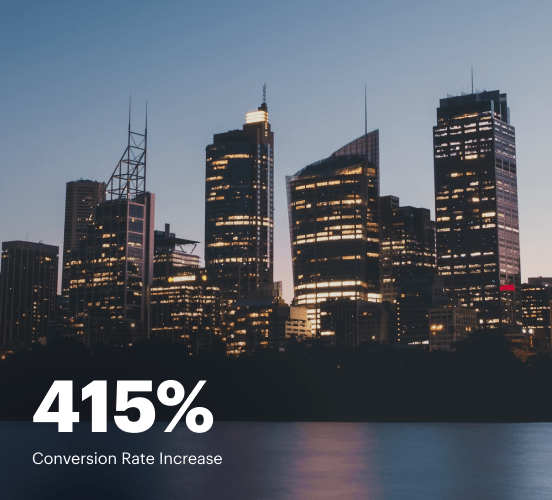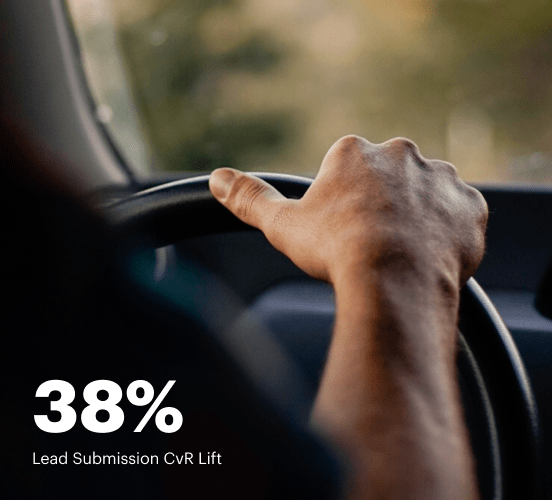How Emma vs. Adobe Portfolio vs. Instapage stack up against each other
Compare Instapage with Emma and Adobe Portfolio to create high-converting landing pages. With personalization, optimization, and collaboration tools, Instapage helps you deliver experiences that drive results.
Get startedSee how Instapage stacks up against the competition
| Feature | Instapage | Other builders |
| Drag-and-Drop Tools | ||
| Conversion-optimized templates | ||
| Manual and AI-powered A/B Tests | ||
| AI content suggestions | ||
| Popups and sticky bars | ||
| Canvas and grid blocks | ||
| Reusable and global elements | ||
| Form and popup builders | ||
| Built-in Heatmaps | ||
| Central analytics dashboard | ||
| Ad-to-page personalization and collections | ||
| Contacts, lists, and email | ||
| Dedicated, full-service CRO experts | ||
| Enterprise-ready platform |
Leading the way in building high-performing landing pages





Why Instapage is the smarter choice for your campaigns
Get everything you need to build, scale, and optimize high-converting landing pages—without coding.

Easier page building without coding
Instapage offers a flexible and seamless page creation experience with a library of 500+ conversion-focused layouts, Instablocks®, a drag-and-drop builder, and AI content generation. With technologies like Thor Render Engine®, you can create on-brand, mobile-responsive landing pages that load quickly and start converting during initial visitor clicks.

More insights — better results
Instapage lets you see in detail how each landing page experience and variation is performing so you can make targeted changes that boost page conversions. Use heatmaps for a better understanding of on-page activities, run A/B tests and AI-assisted experiments, and then track and evaluate results within robust analytics dashboards.

More personalized experiences
Instapage lets you quickly create high-performing landing pages tailored to each of your ad campaigns. Deliver personalized experiences for distinct audiences using dynamic text replacement. Effortlessly align specific advertisements to unique pages with AdMaps. Monitor audience-level metrics using our advanced data tools.

Built-in collaboration
Instapage collaboration capabilities bring your entire team together to speed up the process of landing page review, approval, and launch. No more frustrating and unnecessary revisions or edits scattered across emails. Provide instant feedback, conduct real-time page edits, and securely share your pages with outside stakeholders.

Free up time for your business
Invest time into business growth, not busy work. Launch landing pages faster with reusable forms and templates. Build once, reuse forever.
Explore all integrations






Easier page building without coding
Instapage offers a flexible and seamless page creation experience with a library of 500+ conversion-focused layouts, Instablocks®, a drag-and-drop builder, and AI content generation. With technologies like Thor Render Engine®, you can create on-brand, mobile-responsive landing pages that load quickly and start converting during initial visitor clicks.
More insights — better results
Instapage lets you see in detail how each landing page experience and variation is performing so you can make targeted changes that boost page conversions. Use heatmaps for a better understanding of on-page activities, run A/B tests and AI-assisted experiments, and then track and evaluate results within robust analytics dashboards.
More personalized experiences
Instapage lets you quickly create high-performing landing pages tailored to each of your ad campaigns. Deliver personalized experiences for distinct audiences using dynamic text replacement. Effortlessly align specific advertisements to unique pages with AdMaps. Monitor audience-level metrics using our advanced data tools.
Built-in collaboration
Instapage collaboration capabilities bring your entire team together to speed up the process of landing page review, approval, and launch. No more frustrating and unnecessary revisions or edits scattered across emails. Provide instant feedback, conduct real-time page edits, and securely share your pages with outside stakeholders.
Free up time for your business
Invest time into business growth, not busy work. Launch landing pages faster with reusable forms and templates. Build once, reuse forever.
Explore all integrationsGet started with Instapage in a few steps
-
Create your Instapage account
Start with Instapage by signing up via Google or your email. You'll get access to a free 14-day trial to discover Instapage capabilities. Feel free to cancel anytime during the 14-day trial if you decide that our product is not suitable for your business. -
Build and personalize your page
Create your first landing page from scratch or choose a template from 500+ customizable layouts. Use the drag-and-drop builder to add page elements, fonts, and backgrounds, refine content with AI, or add custom HTML, Javascript, and CSS. -
Review and make edits
Collaborate on page designs and streamline review processes. Invite your team members and stakeholders to review, edit, and provide feedback on your landing page. Collaborate knowing your page is confidential and only accessible to authorized users. -
Publish and track page performance
Publish your page to a domain or custom URL. Connect your pages to the ads you've created and track page performance within the analytics dashboard, run A/B tests and AI experiments, analyze results, and continuously optimize your landing page to maintain high conversions.
Instapage vs. Emma vs. Adobe Portfolio – Which Landing Page Builder is Right for You?
Choosing the right landing page builder can feel like assembling your perfect dream team - much like picking your favorite superheroes to tackle the next big challenge. Each tool brings its unique strengths to the table, making the decision more than just about features; it’s also about finding that perfect fit for your marketing strategy. This article will thoroughly explore how Instapage, Emma, and Adobe Portfolio compare in various essential areas. Using engaging language and a side-by-side evaluation, we will guide you through the nuances of each platform. Along the way, we will reveal how Instapage empowers marketers to reduce costs, improve conversions, and deliver tailored landing page experiences, all while building trust and customer loyalty. Buckle up for an informative ride through the digital landscape!
Meet the Contenders: Who Are Our Players?
In the left corner, we have Instapage, known for its impressive array of customizable features that make creating landing pages a breeze. It targets marketers who want to simplify their workflow without compromising the quality of their campaigns. In the right corner, we have Emma, leveraging its email marketing prowess to provide a seamless experience for creating landing pages that connect with audiences. Finally, in the center ring, we have Adobe Portfolio, the artistic heavyweight that shines when it comes to showcasing creative works. Each of these platforms has carved a niche for itself, presenting a compelling case for marketers seeking the ideal landing page builder. Whether it’s Instapage’s sophisticated conversion tools, Emma’s email integration, or Adobe Portfolio’s design capabilities, each contender has a unique story that appeals to different marketing needs. Let’s explore their features and how they compete within this digital arena.
Round One – Features That Make a Difference
Template Variety and User Experience: A Feature Showdown
Let’s dive into the feature sets of each contender, particularly focusing on their template offerings and the ease with which users can create stunning landing pages. Instapage stands out for its enormous library of high-quality, customizable templates designed specifically for conversion optimization. Each template is crafted with attention to detail, allowing marketers to engage visitors effectively from the get-go. Emma, while primarily known for its email marketing, also provides an appealing selection of landing page templates that emphasize integration and simplicity in design. Meanwhile, Adobe Portfolio focuses on artistic templates that are visually stunning, perfect for creative portfolios but with less focus on conversion elements. User experience is vital here; Instapage boosts usability with an intuitive drag-and-drop editor, while Emma and Adobe Portfolio also strive to provide smooth, user-friendly interfaces. The distinct features of each tool can cater to different user needs, ensuring there is something for every marketer.
Instapage: Your Go-To Tool for Customization and Conversion
With Instapage, marketers get more than just a landing page builder—they gain a dedicated partner in their success. The platform is packed with advanced customization options, allowing you to create a landing page that aligns perfectly with your brand and message. Instapage enables A/B testing, making it easy to compare different designs and understand which performs better regarding conversion rates. The streamlined workflow and dedicated focus on optimizing the landing page experience help empower marketers to reduce costs and foster customer loyalty. Instapage is designed to develop relevant landing page experiences that enhance brand trust, making it an invaluable tool for marketers looking to deepen their relationships with customers. Its comprehensive analytics feature offers insights into visitor behavior, helping you adjust strategies instantly for better results.
Round Two – Speed and Performance: The Need for Speed
Now, let’s discuss speed and performance—critical components of user experience. Picture this: You’ve finally decided to grab your favorite coffee, but the line is long, and the barista is moving at a snail’s pace. Frustrating, isn’t it? Slow-loading landing pages can have a similar effect on potential customers. Instapage recognizes that speed is crucial and offers optimized loading times to keep visitors engaged. Emma also provides decent performance, ensuring quick loading, particularly for its email campaigns. Adobe Portfolio, while visually appealing, may suffer from slower loading times depending on the complexity of the designs. Users generally prefer swift landing pages that offer seamless navigation and quick access to the desired information, leading to higher conversion rates. Let’s break down the advantages each platform has in terms of speed and performance.
Benefits of Instapage in Speed and Performance:
- Optimized for fast loading times, ensuring quick access for users.
- Performance tracking tools help marketers identify areas for improvement.
- Automated features like Dynamic Text Replacement enhance user experience without slowing down.
- Integration with CDN resources guarantees global accessibility and speed.
Advantages of Emma in Speed and Performance:
- Utilizes efficient code structures for rapid email and landing page loading.
- Offers a snapshot of campaign performance which indirectly reflects on landing page speed.
- Responsive design ensures that pages load well on any device.
Strengths of Adobe Portfolio in Speed and Performance:
- Excellent for creative designs but may experience slower loading times with complex visuals.
- Focuses on showcasing high-quality images that can impact load speeds.
- Integrated with Adobe Cloud which optimizes resource management for quicker loading.
In conclusion, speed and performance matter greatly in the world of landing pages. While Instapage leads the charge with its focus on optimized loading times and quick user access, Emma does well in keeping up with its efficient structures. Adobe Portfolio shines visually but may not always match the speedy experience offered by the other two. Therefore, when choosing a landing page builder, marketers should consider how speed can influence customer satisfaction and ultimately conversion rates.
Round Three – Usability: Friendly for All Users
In this round, let’s evaluate usability and the learning curve of each platform. Imagine being in a cozy coffee shop where the staff are friendly experts, ready to guide you through your first cup of coffee. Each of these platforms offers similar friendly environments, welcoming both new users and seasoned marketers. Instapage is intuitive, featuring a user-friendly interface that offers drag-and-drop capabilities, allowing anyone to create lovely landing pages irrespective of their technical skills. Emma simplifies the user experience, particularly for those already familiar with email marketing, enhancing the transition between creating campaigns and landing pages. On the other hand, Adobe Portfolio is primarily designed for creatives who may need a few extra hours to find their footing. Despite this, once familiar, its usability becomes apparent. Overall, regardless of your level of expertise, you'll find resources and support to help you become proficient with these platforms.
Round Four – Customer Support: Your Trusty Sidekicks
In the realm of customer support, each platform has its unique approach to being a helpful assistant. Picture them as loyal sidekicks, always ready to lend a hand when challenges arise. Instapage offers comprehensive support options, including live chat, email, and even a robust knowledge base replete with guides and tutorials to empower users. Emma follows suit with various support avenues, ensuring users can connect through chat, email, or community forums. Adobe Portfolio’s support focuses on providing access to extensive design resources and tutorials, though live assistance may not always be as readily available. Each platform’s customer support reflects its mission to help users navigate their tools effectively and ensure that customers feel valued and supported throughout their journey.
Round Five – Pricing and Plans: Finding Your Best Match
Finally, let’s explore the pricing structures of our contenders, aiming to unpack which platform provides the best value for various marketing needs. Instapage offers transparent pricing with plans tailored for different sizes of businesses, empowering marketers with features that enhance conversion rates at competitive price points. Emma's pricing also reflects its commitment to email integration and landing page creation, catering to marketers who prioritize connection and continuity across their campaigns. Adobe Portfolio has a pricing structure linked to the Adobe Creative Cloud, making it appealing for creatives who want a comprehensive suite, but less so for those focused solely on landing pages. By examining each platform's pricing, users can identify the best financial fit for their specific objectives and marketing strategies.
In wrapping up, while each of these platforms has its own strengths and weaknesses, selecting the right tool for you hinges on your individual needs and goals. Reflect on what matters most in a landing page builder—whether it is features, support, usability, or pricing flexibility. Ultimately, considering the evaluation presented, Instapage appears to be the optimal choice, particularly for those eager to boost conversions and enhance customer interactions. We encourage you to take Instapage for a spin with a free trial, giving it a chance to shine in your marketing toolbox!










